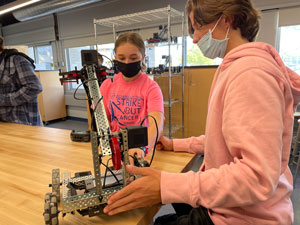Students Learn College-Level Engineering at Mahopac High School

The VEX V5 robots raced across the table, grabbed plastic cones and returned them to the teams of students competing to collect the most cones in a two-minute stretch.
The robotics race may have looked like a game, and the students’ cheers and laughter certainly made it sound like one, but there was serious science behind it.
“We start with a friendly challenge and then move on to solve complex design problems,” said Thomas Mellin, who teaches the Principles of Engineering class at Mahopac High School. “Later, the students’ Chromebooks will connect to a coding platform that links to the robots. We use VEX VR, a virtual program, to introduce them to coding and machine control.”
Mellin, who holds degrees in physics and education, teaches three engineering courses for students in grades 9 through 12. He works closely with another engineering teacher, Jennifer Johnston, whose experience as a chemical engineer includes work at IBM and several other companies.
The classes are held in the high school’s new STEM area, which is designed to cultivate student interest in science, technology, engineering, and mathematics and prepare them for college and careers.
“This is so much fun,” said Anthony Pfeifer, 16. “It helps me learn what I want to do. If someone is thinking about engineering, I’d say definitely take these classes.”
Though only a junior, Pfeifer is already certain he wants to study engineering.
Victoria Longo, a senior, juggled her schedule to make sure the engineering class fit.
“I’ve been trying to teach myself coding and I know how to write a basic if-then statement,” said Longo, describing a programming command for making decisions. “But, if I want to be a chemical engineer, do I still need coding?”
To which her teacher answered: all types of engineers need computing and coding skills now.
Thus began the coding part of the class, where the dozen or so students each created code to maneuver an on-screen robot to pick up a cone, mimicking their real-world robot challenge.
It was just another day of fun, games and high-tech learning in a STEM classroom.
“The students are engaged and excited about every challenge we give them,” Mellin said. ”I’m so privileged to have the opportunity to apply physics to engineering and focus on problem-solving and design with students.”

Examiner Media – Keeping you informed with professionally-reported local news, features, and sports coverage.
